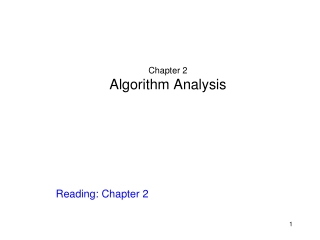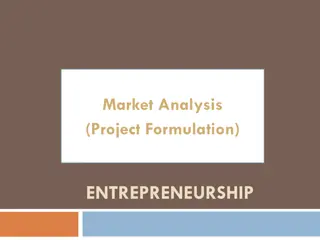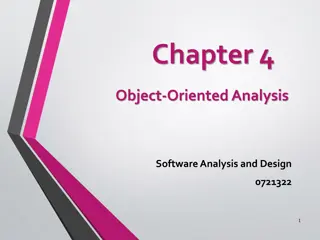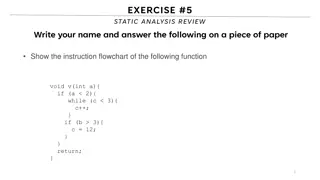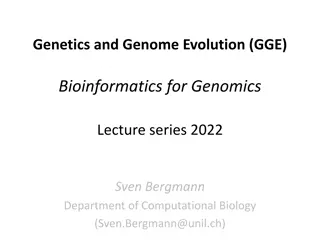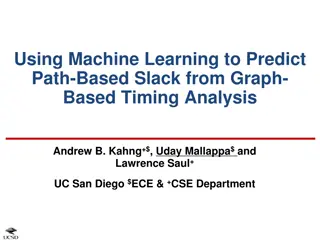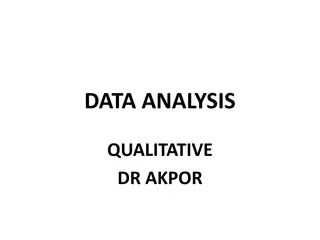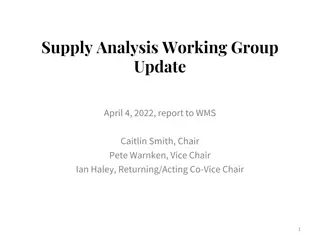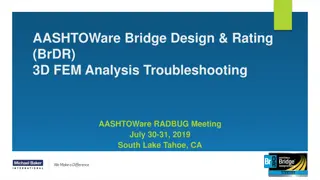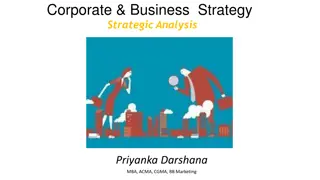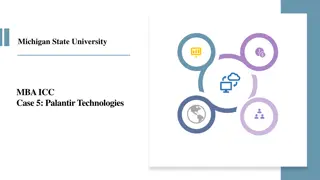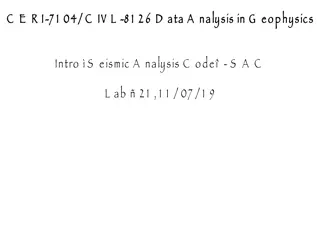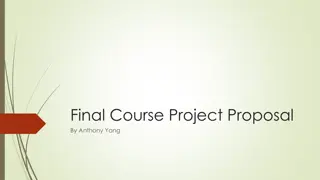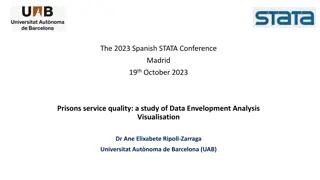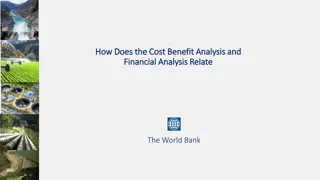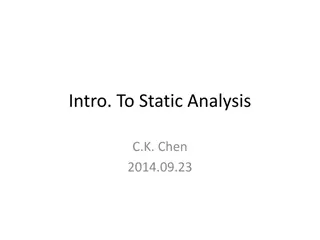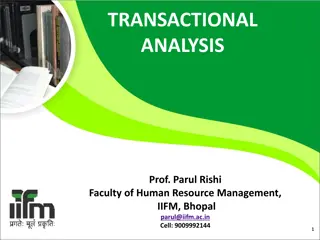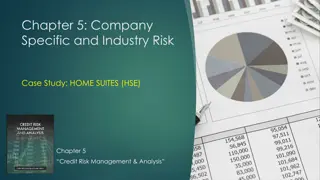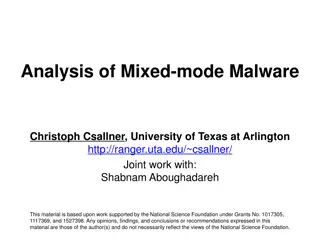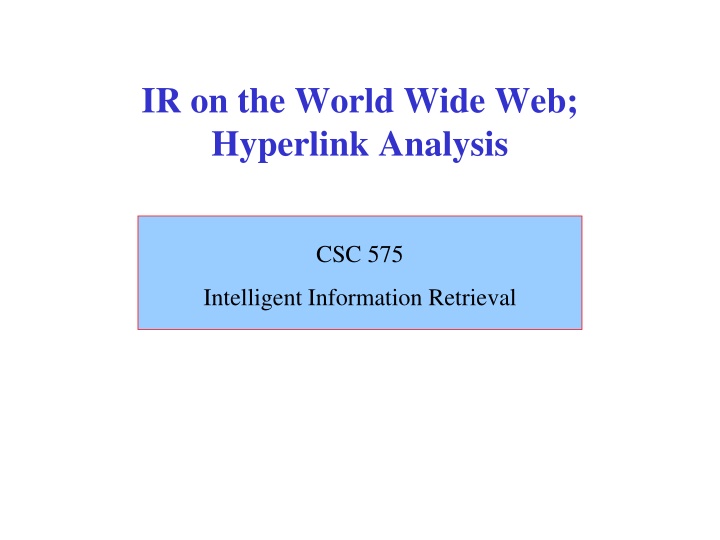
Intelligent Information Retrieval Techniques for Web Analysis
Discover the intricacies of hyperlink analysis and web crawling in the context of intelligent information retrieval. Explore strategies such as breadth-first and depth-first search, and the importance of avoiding page duplication in search algorithms. Delve into spidering algorithms and learn about the web as a directed graph, providing insights into how search engines navigate the vast expanse of the internet.
Download Presentation

Please find below an Image/Link to download the presentation.
The content on the website is provided AS IS for your information and personal use only. It may not be sold, licensed, or shared on other websites without obtaining consent from the author. If you encounter any issues during the download, it is possible that the publisher has removed the file from their server.
You are allowed to download the files provided on this website for personal or commercial use, subject to the condition that they are used lawfully. All files are the property of their respective owners.
The content on the website is provided AS IS for your information and personal use only. It may not be sold, licensed, or shared on other websites without obtaining consent from the author.
E N D
Presentation Transcript
IR on the World Wide Web; Hyperlink Analysis CSC 575 Intelligent Information Retrieval
Sec. 21.1 The Web as a Directed Graph hyperlink Page B Page A Anchor Things to consider beyond standard IR Allows for navigation across sets of potentially related documents Hyperlinks between pages may denote a conferral of quality or authority The text in the anchor of a hyperlink on page A could be used as a description of the target page B Highly dynamic and high degree of duplication
Web Search Web Spider/Crawler Document corpus IR Query String System 1. Page1 2. Page2 3. Page3 . . Ranked Documents 3 Intelligent Information Retrieval
Spiders (Robots/Bots/Crawlers) Start with a comprehensive set of root URL s from which to start the search. Follow all links on these pages recursively to find additional pages. Index all novel found pages in an inverted index as they are encountered. May allow users to directly submit pages to be indexed (and crawled from). 4 Intelligent Information Retrieval
Search Strategy Trade-Offs Breadth-first search strategy explores uniformly outward from the root page but requires memory of all nodes on the previous level (exponential in depth). Standard spidering method. Depth-first search requires memory of only depth times branching-factor (linear in depth) but gets lost pursuing a single thread. Both strategies implementable using a queue of links (URL s). 5 Intelligent Information Retrieval
Avoiding Page Duplication Must detect when revisiting a page that has already been spidered (web is a graph not a tree). Must efficiently index visited pages to allow rapid recognition test. Tree indexing Hashtable Index page using URL as a key. Must canonicalize URL s (e.g. delete ending / ) Does not detect duplicated or mirrored pages. Index page using textual content as a key. Requires first downloading page. 6 Intelligent Information Retrieval
Spidering Algorithm Initialize queue (Q) with initial set of known URL s. Until Q empty or page or time limit exhausted: Pop URL, L, from front of Q. If L is not an HTML page (.gif, .jpeg, .ps, .pdf, .ppt ) continue loop. If already visited L, continue loop. Download page, P, for L. If cannot download P (e.g. 404 error, robot excluded) continue loop. Index P (e.g. add to inverted index or store cached copy). Parse P to obtain list of new links N. Append N to the end of Q. 7 Intelligent Information Retrieval
Queueing Strategy How new links added to the queue determines search strategy. FIFO (append to end of Q) gives breadth-first search. LIFO (add to front of Q) gives depth-first search. Heuristically ordering the Q gives a focused crawler that directs its search towards interesting pages. May be able to use standard AI search algorithms such as Best-first search, A*, etc. 8 Intelligent Information Retrieval
Restricting Spidering Restrict spider to a particular site. Remove links to other sites from Q. Restrict spider to a particular directory. Remove links not in the specified directory. Obey page-owner restrictions robot exclusion protocol 9 Intelligent Information Retrieval
Multi-Threaded Spidering Bottleneck is network delay in downloading individual pages. Best to have multiple threads running in parallel each requesting a page from a different host. Distribute URL s to threads to guarantee equitable distribution of requests across different hosts to maximize through-put and avoid overloading any single server. Early Google spider had multiple coordinated crawlers with about 300 threads each, together able to download over 100 pages per second. 10 Intelligent Information Retrieval
Directed/Focused Spidering Sort queue to explore more interesting pages first. Two styles of focus: Topic-Directed Link-Directed 11 Intelligent Information Retrieval
Topic-Directed Spidering Assume desired topic description or sample pages of interest are given. Sort queue of links by the similarity (e.g. cosine metric) of their source pages and/or anchor text to this topic description. Preferentially explores pages related to a specific topic. 12 Intelligent Information Retrieval
Link-Directed Spidering Monitor links and keep track of in-degree and out- degree of each page encountered. Sort queue to prefer popular pages with many in- coming links (authorities). Sort queue to prefer summary pages with many out- going links (hubs). 13 Intelligent Information Retrieval
Keeping Spidered Pages Up to Date Web is very dynamic: many new pages, updated pages, deleted pages, etc. Periodically check spidered pages for updates and deletions: Just look at header info (e.g. META tags on last update) to determine if page has changed, only reload entire page if needed. Track how often each page is updated and preferentially return to pages which are historically more dynamic. Preferentially update pages that are accessed more often to optimize freshness of more popular pages. 14 Intelligent Information Retrieval
Quality and the WWW The Case for Connectivity Analysis Basic Idea: mine hyperlink information on the Web Assumptions: links often connect related pages a link between pages is a recommendation Approaches classic IR: co-citation analysis (a.k.a. bibliometrics ) connectivity-based ranking (e.g., GOOGLE) HITS - hypertext induced topic search 15 Intelligent Information Retrieval
Co-Citation Analysis Has been around since the 50 s (Small, Garfield, White & McCain) Used to identify core sets of authors, journals, articles for particular fields of study Main Idea: Find pairs of papers that cite third papers Look for commonalities http://www.garfield.library.upenn.edu/papers/mapsciworld.html 16 Intelligent Information Retrieval
Co-citation analysis (From Garfield 98) The Global Map of Science, based on co- citation clustering: Size of the circle represents number of papers published in the area; Distance between circles represents the level of co-citation between the fields; By zooming in, deeper levels in the hierarchy can be exposed. 17 Intelligent Information Retrieval
Co-citation analysis (From Garfield 98) Zooming in on biomedicine, specialties including cardiology, immunology, etc., can be viewed. 18 Intelligent Information Retrieval
Co-citation analysis (From Garfield 98) 19 Intelligent Information Retrieval
Citations vs. Links Web links are a bit different than citations: Many links are navigational. Many pages with high in-degree are portals not content providers. Not all links are endorsements. Company websites don t point to their competitors. Citations to relevant literature is enforced by peer-review. Authorities pages that are recognized as providing significant, trustworthy, and useful information on a topic. In-degree (number of pointers to a page) is one simple measure of authority. However in-degree treats all links as equal. Should links from pages that are themselves authoritative count more? Hubs index pages that provide lots of useful links to relevant content pages (topic authorities). 20 Intelligent Information Retrieval
Hypertext Induced Topic Search Basic Idea: look for authority and hub web pages (Kleinberg 98) authority: definitive content for a topic hub: index links to good content The two distinctions tend to blend Procedure: Issue a query on a term, e.g. java Get back a set of documents Look at the inlink and outlink patterns for the set of retrieved documents Perform statistical analysis to see which patterns are the most dominant ones Technique was initially used in IBM s CLEVER system can find some good starting points for some topics doesn t make explicit use of content (so may result in topic drift from original query) 21 Intelligent Information Retrieval
Hypertext Induced Topic Search Intuition behind the HITS algorithm Authority comes from in-edges Being a good hub comes from out-edges Mutually re-enforcing relationship Better authority comes from in-edges of good hubs Being a better hub comes from out-edges of to good authorities A good authority is a page that is pointed to by many good hubs. A good hub is a page that points to many good authorities. Together they tend to form a bipartite graph Hubs Authorities 22 Intelligent Information Retrieval
HITS Algorithm Compute hubs and authorities for a particular topic specified by a normal query. 1. First determine a set of relevant pages for the query called the base set (base subgraph) S. For a specific query Q, let the set of documents returned by a standard search engine be called the root set R. Initialize S to R. Add to S all pages pointed to by any page in R. Add to S all pages that point to any page in R. Analyze the link structure of the web subgraph defined by S to find authority and hub pages in this set. S R 23 Intelligent Information Retrieval
HITS Algorithm Let HUB[v] and AUTH[v] represent the hub and authority values associated with a vertex v Repeat until HUB and AUTH vectors converge Normalize HUB and AUTH HUB[v] := AUTH[ui] for all ui with Edge(v, ui) AUTH[v] := HUB[wi] for all ui with Edge(wi, v) w1 u1 v w2 ... u2 ... A H wk uk 24 Intelligent Information Retrieval
HITS: Algorithm Highlights Use an iterative algorithm to slowly converge on a mutually reinforcing set of hubs and authorities. Maintain for each page p S: Authority score: ap (vectora) Hub score: hp (vectorh) Initialize all ap = hp = 1 Maintain normalized scores: ( ) ( ) a S p S p 2= 2= 1 p h 1 p Authorities are pointed to by lots of good hubs: a q : = h p q q p Hubs point to lots of good authorities: p : = h a p q q q 25 Intelligent Information Retrieval
Illustrated Update Rules 1 a4 = h1 + h2 + h3 4 2 3 5 4 6 h4 = a5 + a6 + a7 7 26 Intelligent Information Retrieval
HITS Iterative Algorithm Initialize for all p S: ap = hp = 1 For i = 1 to k: For all p S: (update auth. scores) For all p S: (update hub scores) p q : q : = a h p q q p = h a p q q ( ) S p S p 2= / 1 a pc For all p S:ap= ap/c c: (normalizea) Divide a and h vectors by their norms ( ) 2= / 1 h pc For all p S:hp= hp/c c: (normalizeh) 27 Intelligent Information Retrieval
HITS Example B D First Iteration C A D A C B E a: [0.0, 0.0, 2.0, 2.0, 1.0] E D A C B E h: [4.0, 5.0, 0.0, 0.0, 0.0] Normalize: divide each vector by its norm (square root of the sum of the squares) D A C B E Norm a: [0.0, 0.0, 0.67, 0.67.0, 0.33] D A C B E Norm h: [0.62, 0.78, 0.0, 0.0, 0.0] 28 Intelligent Information Retrieval
Convergence Algorithm converges to a fix-point if iterated indefinitely. Define A to be the adjacency matrix for the subgraph defined by S. Aij= 1 for i S, j S iff i j Authority vector, a, converges to the principal eigenvector of ATA Hub vector, h, converges to the principal eigenvector of AAT In practice, 20 iterations produces fairly stable results. 29 Intelligent Information Retrieval
Sec. 21.3 Proof of Convergence n n adjacency matrix A: each of the n pages in the base set has a row and column in the matrix. Entry Aij = 1 if page i links to page j, else = 0. 1 2 3 0 1 0 1 2 1 2 1 1 1 3 1 0 0 3
Sec. 21.3 Hub/authority vectors View the hub scores h() and the authority scores a() as vectors with n components. Recall the iterative updates x ( ) ( ) h x a y y y ( ) ( ) a x h y x
Sec. 21.3 Proof of Convergance h = Aa a = ATh AT is the transpose of A. Substituting, h = AATh and a = ATAa So, h is an eigenvector of AAT and a is an eigenvector of ATA. In fact, the iterative algorithm is a particular, known algorithm for computing eigenvectors Guaranteed to converge.
HITS: Other Applications Finding Similar Pages Using Link Structure Similar Pages to honda.com : - toyota.com - ford.com - bmwusa.com - saturncars.com - nissanmotors.com - audi.com - volvocars.com Given a page, P, let R (the root set) be t (e.g. 200) pages that point to P. Grow a base set S from R. Run HITS on S. Return the best authorities in S as the best similar-pages for P. Finds authorities in the link neighbor-hood of P. 33 Intelligent Information Retrieval
HITS: Other Applications HITS for Clustering An ambiguous query can result in the principal eigenvector only covering one of the possible meanings. Non-principal eigenvectors may contain hubs & authorities for other meanings. Example: jaguar : Atari video game (principal eigenvector) NFL Football team (2nd non-princ. eigenvector) Automobile (3rd non-princ. eigenvector) An application of Principle Component Analysis (PCA) 34 Intelligent Information Retrieval
HITS: Problems and Solutions Some edges are wrong (not recommendations ) multiple edges from the same author automatically generated spam Solution: weight edges to limit influence Topic Drift Query: jaguar AND cars Result: pages about cars in general Solution: analyze content and assign topic scores to nodes 35 Intelligent Information Retrieval
Modified HITS Algorithm Let HUB[v] and AUTH[v] represent the hub and authority values associated with a vertex v Repeat until HUB and AUTH vectors converge Normalize HUB and AUTH HUB[v] := AUTH[ui] . TopicScore[ui] . Weight(v, ui) for all ui with Edge(v, ui) AUTH[v] := HUB[wi]. TopicScore[wi] . Weight(wi, v) for all ui with Edge(wi, v) Topic score is determined based on similarity measure between the query and the documents 36 Intelligent Information Retrieval
IR on the World Wide Web; Hyperlink Analysis Part II CSC 575 Intelligent Information Retrieval
PageRank Alternative link-analysis method used by Google (Brin & Page, 1998). Does not attempt to capture the distinction between hubs and authorities. Ranks pages just by authority. Applied to the entire Web rather than a local neighborhood of pages surrounding the results of a query. 38 Intelligent Information Retrieval
Initial PageRank Idea Just measuring in-degree (citation count) doesn t account for the authority of the source of a link. Initial page rank equation for page p: ( ) R q q : = ( ) R p c N q p q Nq is the total number of out-links from page q. A page, q, gives an equal fraction of its authority to all the pages it points to (e.g. p). c is a normalizing constant set so that the rank of all pages always sums to 1. 39 Intelligent Information Retrieval
Initial PageRank Idea Can view it as a process of PageRank flowing from pages to the pages they cite. .08 .1 .05 .05 .03 .09 .08 .03 .03 .03 40 Intelligent Information Retrieval
Initial PageRank Algorithm Iterate rank-flowing process until convergence: Let S be the total set of pages. Initialize p S: R(p) = 1/|S| Until ranks do not change (much) (convergence) For each p S: ( ) R q q : = ( ) R p N q p q p = / 1 ( ) c R p S For each p S: R(p) = cR (p) (normalize) 41 Intelligent Information Retrieval
Sample Stable Fixpoint 0.2 0.4 0.2 0.2 0.2 0.4 0.4 42 Intelligent Information Retrieval
Linear Algebra Version Treat R as a vector over web pages. Let A be a 2-d matrix over pages where Avu= 1/Nuif u v elseAvu= 0 Then R = cAR R converges to the principal eigenvector of A. 43 Intelligent Information Retrieval
Problem with Initial Idea A group of pages that only point to themselves but are pointed to by other pages act as a rank sink and absorb all the rank in the system. Solutions: Rank Score Introduce a rank source E that continually replenishes the rank of each page, p, by a fixed amount E(p). ( ) R q : q q = + ( ) ( ) R p c E p N p q 44 Intelligent Information Retrieval
Random Surfer Model The modified PageRank can be seen as modeling a random surfer that starts on a random page, then: With probability E(p) randomly jumps to page p. Otherwise, randomly follows a link on the current page. R(p) models the probability that this random surfer will be on page p at any given time. E jumps are needed to prevent the random surfer from getting trapped in web sinks with no outgoing links. Guarantees that the underlying Markov chain is not ergodic 45 Intelligent Information Retrieval
PageRank Algorithm Let S be the total set of pages. Let p S: E(p) = /|S| (for some 0< <1, e.g. 0.15) Initialize p S: R(p) = 1/|S| Until ranks do not change (much) (convergence) For each p S: S p ( ) R q = + ( ) ( ) R p E p N : q q p q = / 1 ( ) c R p For each p S: R(p) = cR (p) (normalize) 46 Intelligent Information Retrieval
PageRank Example A C B Initial R: [0.33, 0.33, 0.33] B A = 0.3 First Iteration Only: C R (C): R(A)/2 + R(B)/1 + 0.3/3 R (B): R(A)/2 + 0.3/3 R (A): 0.3/3 A C B R : [0.1, 0.595, 0.27] before normalization: Normalization factor: 1/[R (A)+R (B)+R (C)] = 1/0.965 A C B R: [0.104, 0.617, 0.28] after normalization: Intelligent Information Retrieval
Speed of Convergence Early experiments on Google used 322 million links. PageRank algorithm converged (within small tolerance) in about 52 iterations. Number of iterations required for convergence is empirically O(log n) (where n is the number of links). Therefore calculation is quite efficient. 48 Intelligent Information Retrieval
Google Ranking Complete Google ranking includes (based on university publications prior to commercialization). Vector-space similarity component. Keyword proximity component. HTML-tag weight component (e.g. title preference). PageRank component. Details of current commercial ranking functions are trade secrets. 49 Intelligent Information Retrieval
Personalized PageRank PageRank can be biased (personalized) by changing E to a non-uniform distribution. Restrict random jumps to a set of specified relevant pages. For example, let E(p) = 0 except for one s own home page, for which E(p) = This results in a bias towards pages that are closer in the web graph to your own homepage. Similar personalization can be achieved by setting E(p) for only pages p that are part of the user s profile. 50 Intelligent Information Retrieval

